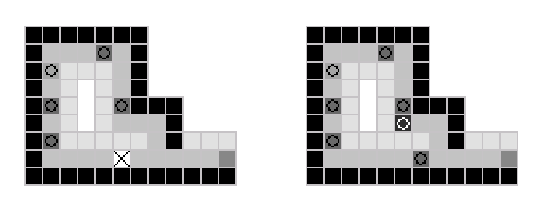Information Technology Reference
In-Depth Information
Some features that are not present in these models have been introduced, however.
The paths are constituted of three layers: two sheaths and a “fluid” along which the
signals can flow. The two sheaths are different: one of them is intended to serve as the
external perimeter of the entire pattern (hard boundary) while the other one faces its
internal part (soft boundary). The asymmetry provides a sense for the signals to flow.
Besides, the sheaths are intended to protect the pattern from the external
perturbations, but the hard one is a stronger barrier than the soft one. The latter shall
allow the penetration of any incoming constructing arm (perhaps the own one, or
perhaps belonging to another pattern) so that the new-born loop can be closed during
reproduction.
As usual the signals duplicate when arriving to the junction of the loop with its
construction arm, so that one copy is sent to the outside, while another one remains in
the cyclic part of the path.
The shape and size of the reproducing patterns can be arbitrary (see Fig. 1). This
feature, which was present in our previous self-inspecting model [12], has been
extended also to the genetic version due to the asymmetry of the sheaths. Since the
signals get their orientation from polarity of the borders of the path, they can be coded
in just one cell. The immediate consequence is that any pattern has enough room to
incorporate a detailed self-description. In any case, it is still possible to use more
compact descriptions for symmetric patterns.
Fig. 1.
Examples of reproducing loops belonging to both models. Both carry signals that self-
describe the loop by means of the appropriate
construction orders
(with a cercle), but the self-
inspecting one (left) includes also a
self-inspecting signal
(with a cross), which is precisely who
is generating the signal array.
The number of states is 16. Three of them code the mentioned structural
components of the loops, while 12 serve to represent the different constructing, self-
inspecting and control signals. A Moore neighborhood is used with radius 1 (8
neighbors are significant for the transition function).
The way reproduction is carried out varies according to the reproduction strategy.
In the genetic model the pattern needs a combination of constructing signals that act
as its self-description. When they are executed in the outside cellular space, an exact
copy of the pattern is generated. On the other side, the self-inspecting model needs
only one instance of the self-inspecting signal inside the pattern. This signal runs
along the path that defines the loop and reads its shape at the same time. As a
consequence, appropriate constructing signals are generated, exported and executed to
produce a copy of the pattern.

